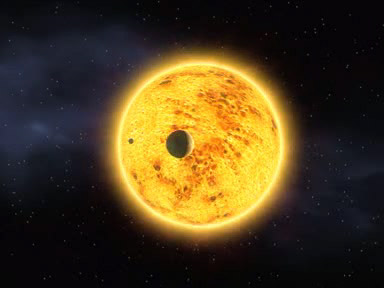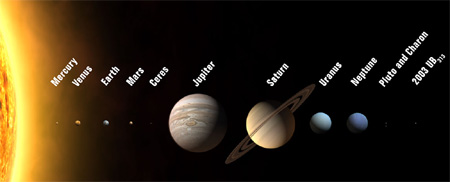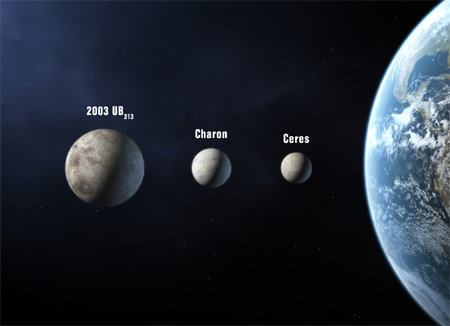Can satellites be planets? - badastronomy blog
I am very happy to see that other people are equally unhappy about the "satellite rules".
There has to be a definition of a planet. The fast pace of new objects discovery in and out the solar system leaves no choice to the scientific community.
The good thing with a lower mass/size limit is that it is easy to determine empirically. Yes, it is arbitrary but any other rules would be. We all agree with that.
Now, why can't we call a satellite a planet? What if Saturn did get ejected from the solar system? What would it be?
The full logic of defining a planet through its size and mass characteristics is to revolutionize once more the astronomy semantics by defining Ganymede, Titan, Callisto, the Moon, Io, Europa and many others as... planets!
What matters is to show the non-scientific communauty how diversified the solar system is.
Have you ever tried to convince someone that Titan is an important place to explore? Isn't it frustrating that Titan is only defined as a satellite of Saturn and not as a "planet" on nearly equal footing with Mars?
How can we explain to the wider public than the Jupiter system is like a "miniature" solar system? Wouldn't it be easier to say that this system includes 4 more (smaller) planets: Europa, Io, Ganymede and Callisto?
Sailom
http://www.badastronomy.com/bablog/2006/08/15/congratulations-its-a-planet/
Here’s the news the whole world has been waiting for…
And there’s more news:
Well, sortof. It’s not official yet, and won’t be until at least Thursday. Sit back, folks, because this’ll take some ’splaining.

Here’s the deal. There is a subgroup in the International Astronomical Union that decides about the naming of names, and the categorizing of, um, categories for astronomical objects. For quite some time, they have been pondering whether to call Pluto a planet or not. There has been a lot of controversy about this, mostly in the media and the public, since most astronomers don’t care all that much.
Why argue this at all? Because Pluto isn’t like other planets. It’s weird. It’s little, far smaller than any other planet. It’s an ice ball, where other planets are rock, or metal, or gas giants. It’s way far out from the Sun, and on a very elliptical orbit, and the orbit is tilted with respect to the other planets. Far worse, it appears that there are other objects out there beyond Neptune that look an awful lot like Pluto – if we call Pluto a planet, we have to call them planets too… and there might be a lot of them. A lot. Like maybe millions, or even billions. Trillions? Possibly. That’s a lot of planets.
So we have do an issue here, but not the one most people think. It’s not whether Pluto is a planet or not, the real problem is what the heck is a planet?
I don’t think you can scientifically decide what’s a planet and what isn’t (as I’ll get to below). But that’s what the IAU Commission had to decide. And it looks like they did decide. Here’s what they say is now a planet:
1) A planet is a celestial body that (a) has sufficient mass for its self-gravity to overcome rigid body forces so that it assumes a hydrostatic equilibrium (nearly round) shape, and (b) is in orbit around a star, and is neither a star nor a satellite of a planet.
(2) We distinguish between the eight classical planets discovered before 1900, which move in nearly circular orbits close to the ecliptic plane, and other planetary objects in orbit around the Sun. All of these other objects are smaller than Mercury. We recognize that Ceres is a planet by the above scientific definition. For historical reasons, one may choose to distinguish Ceres from the classical planets by referring to it as a “dwarf planet.”
(3) We recognize Pluto to be a planet by the above scientific definition, as are one or more recently discovered large Trans-Neptunian Objects. In contrast to the classical planets, these objects typically have highly inclined orbits with large eccentricities and orbital periods in excess of 200 years. We designate this category of planetary objects, of which Pluto is the prototype, as a new class that we call “plutons”.
(4) All non-planet objects orbiting the Sun shall be referred to collectively as “Small Solar System Bodies”.
These rules have some good things going for them. Most people expected them to come down on the side of planetary status for the little guy. I think the big surprise (well, one of two, but again, patience, I’ll get to it) is calling Ceres a planet.
But overall I’m not happy.
For one thing, if a planet the size of, say, Saturn, gets ejected from a solar system — a scenario that can happen early in the life of a forming system — then under Rule 1 it wouldn’t be a planet. That’s silly. Why should location matter? Also, imagine two planets which are the same size, but one is solid rock and the other is a less solid rock. It’s easy to imagine the first being able to retain a lumpy shape due to its structural strength, while the other one doesn’t, even though it’s the same overall size and mass! Yet under these rules, one is a planet and the other is not.
Rule 3 is arbitrary. What if we find an object bigger than Pluto but with an orbit of 199 years? Actually, there are no planets like this, but I’m making a point: Is that a pluton? What do they mean, exactly, by "highly" inclined? 10°? 20°? I’m not a fan of arbitrary rules, especially in science.
But given these rules, here’s the impact on our solar system:
- There are 8 major planets in the solar system. Mercury, Venus, Earth, Mars, Jupiter, Saturn, Uranus, and Neptune.
- There is a newly named kind of planet: "plutons". Pluto is one, of course. So is Charon, it’s moon (the second big surprise I mentioned above), and UB313, an object slightly larger than Pluto that orbits even farther from the Sun.
- Ceres, once called the largest asteroid, is also now a planet.
 |
| Welcome to our new solar system! |
Now, at the moment this is just a proposed set of rules, and has not yet been ratified. If it does pass, then we have 12 planets in our solar system, and the number will certainly grow as more plutons are found. The final vote will be made by astronomers attending the IAU meeting going on right now in Prague, on Thursday August 24th at 14:00 Prague time, which is 5:00 a.m. Pacific time. I’ll post an update on the vote when I find out how it went. You an also check the group IAU blog as well for updates.
So what do I think of all this? The more I think about it, the less I like it. Ceres is the largest asteroid, and big enough that its own gravity can crush it into a sphere. No other asteroid is big enough or massive enough to do that, but several of the larger asteroids are massive enough that their shapes are modified by gravity, and are "nearly round". Why aren’t they on the list? Maybe they’re not at hydrostatic equilibrium, and geological forces dominate over gravity (in other words, the gravity isn’t enough to totally morph the thing into a ball). But this seems like another somewhat arbitrary line in the sand. How far away from a perfect sphere does an object have to be before it’s tossed out of the planet club?
Pluto being a planet is fine, I suppose, though it opens a can of worms in the way they defined things. Remember, statistically speaking, there really could be millions or more objects like Pluto in the deep dark. As time goes on and our instruments get better, we’ll find ‘em. Guaranteed. We could have millions of planets in the solar system in less than a century as telescopes and techniques get really good.

However, including Charon, Pluto’s moon, as a planet — even as a pluton – opens up a bigger can of worms. Here is the committee’s reasoning:
For two or more objects comprising a multiple object system, the primary object is designated a planet if it independently satisfies the conditions above. A secondary object satisfying these conditions is also designated a planet if the system barycentre resides outside the primary. Secondary objects not satisfying these criteria are “satellites”. Under this definition, Pluto’s companion Charon is a planet, making Pluto-Charon a double planet.
The barycenter is the center-of-mass (CoM) of a system. Since Charon is pretty big compared to Pluto, that CoM is outside Pluto’s surface, so, by their reckoning, Charon is a planet in its own right. But moons’ orbits move over their lifetime, changing the CoM of the system. Right now, the barycenter of the Earth-Moon system is about 1700 kilometers beneath the Earth’s surface. The Moon recedes from the Earth by about 4 centimeters per year, so in 40 million years or so (an eye blink in solar system time) 3 billion years the barycenter will be outside the Earth. Will we call the Moon a planet then (if we’re still around and arguing about this)?
So this rule isn’t really arbitrary, it’s just not very satisfying. But imagine the rule we’d need instead: if you have two objects that orbit each other, and one or both are planets by Rules 1 and 2, then the more massive on is a planet, and the other is just a moon. That’s silly too. What if one is Jupiter-sized and the other is Earth-sized?
Which brings me, finally, to my big point. This is all incredibly silly. We’re not arguing science here. We’re arguing semantics. For years people have tried to make a rigid definition of planet, but it simply won’t work. No matter what parameter you include in the list, I can come up with an example that screws the definition up. I’ve shown that already, and I’m just warming up.
The problem here is simple, really: we’re trying to wrap a scientific definition around a culturally-defined word that has no strict definition. Doing this will only lead to trouble. Why? For one thing, it’s divisive and silly. How does a definition help us at all? And how does it make things less confusing than they already are? Charon is a planet? It’s smaller than our own Moon!
A big step in understanding a new object is being able to categorize it. Is it icy, or rocky? Is the orbit circular, elliptical, far from the Sun, nearby, tilted? This type of information leads to insight on how the object formed, what it’s doing, and how it behaves. This is all important, and so it is a good idea to try to categorize objects. But definitions are like little boxes, containers in which ideas sit. But sometimes they’re more like prison cells. They frame our minds, make us see things too rigidly. Thinking of Pluto as a planet might make us miss some important characteristic because we’re too narrow in our thinking. I’ve seen it happen before, even with me. It’s too easy to be rigid with a definition in your hand.
However, in a sense this doesn’t matter. What’s in a name? Scientists will probably still of Pluto as they always have– an ice ball at the edge of the main solar system. The public will still think of it as a planet, so that won’t change. And, well, there is something cool about this new set of rules. Maybe, just maybe, in a few years we’ll have a solar system with hundreds or even thousands of planets, instead of just the 9 — nuts, I mean 12 — that we have now.

0 Comments:
Post a Comment
<< Home